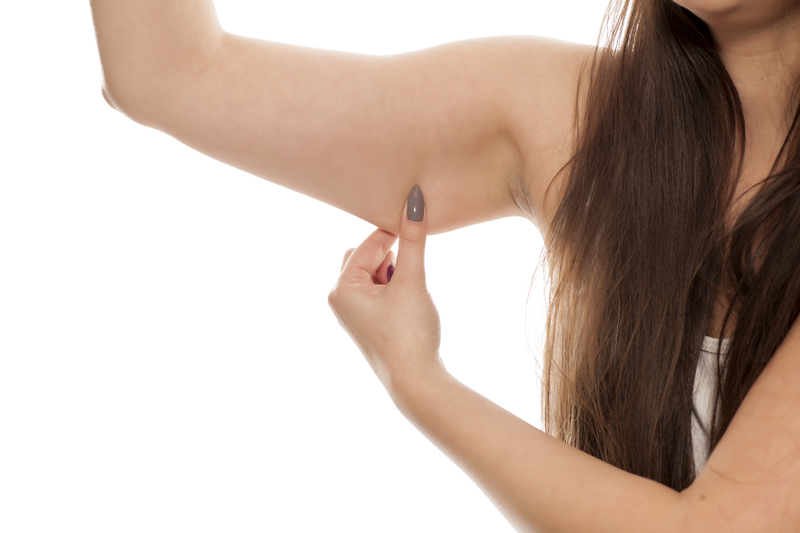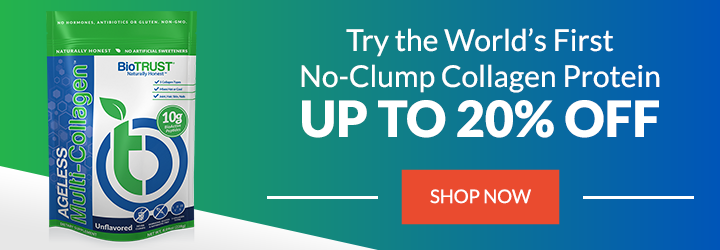How to Tighten Loose Skin After Weight Loss (8 Easy Steps)

Don’t get me wrong, I would never want to go back to where I was before. I feel so much better now and am able to do so much more! But I have to admit that I’m embarrassed by the appearance of excess skin and the way it just hangs. While I feel much more comfortable in my clothes, I really don’t like to reveal what’s underneath. But here’s the deal: I love going to the lake and boating with my family over the summer, and I don’t want to cover up for the rest of my life.
Is there anything I can do about the loose skin after weight loss (and expensive, potentially dangerous surgery is not an option)?
–Sara
A: Sara, first off, congratulations! That is absolutely amazing, and you should feel proud of the changes you’ve made and the successes you’ve enjoyed! You’ve done it—yippee!
You’ve worked hard and put in the necessary effort, and you deserve to feel amazing about your leaner, healthier body, and more importantly, about the lifestyle changes you’ve made to improve your quality (and likely quantity) of life and your health span.
As you know, when undergoing a life transformation, it’s not just about the number on the scale but the numerous non-scale victories along the way.
Of course, as our bodies change, our most visible organ (the skin) changes as well. Plus, as we get older, our skin begins to sag due to age (and the natural loss of the structural proteins, elastin and collagen, that make up the skin). This sagging can be made worse by significant weight loss (as you’ve experienced). along with smoking, excess sun exposure, and dehydration.
In addition, especially if you carried excess weight for a longer period of time, the collagen and elastin fibers may have become damaged, which can lesson their ability to bounce back. 1
While your skin may never be as tight and smooth as when you were younger, skin can shrink, expand, and then shrink again. And there’s a number of steps you can take to help tighten up loose skin after weight loss and improve its elasticity.
8 Steps to Tighten Loose Skin After Weight Loss
Step 1: Assess your skin
While you have obviously lost a great deal of weight, what appears to be loose skin can actually be body fat. If you can pinch more than a couple of millimeters of skin, then you may have more fat to lose. This fat under the skin (called “subcutaneous fat”) can make it look like your skin is sagging. This is especially true for those stubborn fat deposits, such as around the midsection for men and on the hips, thighs, and lower belly for women.
If that’s the case, as you continue to lose fat, your skin will likely start to look tighter.
If you only have a few millimeters or less to pinch and if it looks/feels more like crinkled paper, then it is likely excess skin.
Step 2: Build more muscle
Increasing muscle size may give the appearance of tighter skin and help better define your overall shape. While cardio exercise can help you lose weight, the most effective way to change the shape of your body is to increase your muscle mass. And the best way to do that is lifting weights or some other type of resistance training. With weight training, you can sculpt firmer, more toned arms, better-defined shoulders, and leaner, more shapely legs, to name a few.
If your problem areas are on your hips, thighs, and butt, you can use body-weight exercises and weight training to increase your muscle size, helping lift, tone, and tighten these areas. While increasing muscle mass doesn’t “shrink” the skin, it can help improve your appearance by filling in some of the areas that were stretched out from the excess fat you used to carry.
It can take time to notice the results (up to a couple of years according to some reports) and everyone is different, but in addition to improving your body’s shape, a regular resistance training program has numerous benefits, including increasing health span.
Step 3: Eat enough protein
When it comes to building more muscle, another crucial component is making sure you’re consuming plenty of high quality protein. Your body uses the amino acids it gets from protein to build and repair tissues, and that includes skin and lean muscle mass. Optimizing protein intake can positively impact skin texture, dryness, elasticity and the appearance of loose skin after weight loss. In addition, it can help you build more muscle, increase strength, and support fat loss.
Step 4: Eat fatty fish
Cold-water, oily fish (such as salmon, sardines, mackerel, and herring) not only provide a healthy dose of protein, they are also great sources of omega-3 fatty acids, which are vital for healthy skin. 2 Omega-3 fats have been shown to help our bodies fight inflammation, help prevent skin dryness, and even make our skin less susceptible to the potentially damaging effects of excessive UV ray exposure. 3 Fish is also a great source of vitamin E, another nutrient essential for skin health. 4
Step 5: Stay hydrated
It should come as no surprise that keeping the skin hydrated improves its look and feel. 5 Drinking enough water not only helps keep the skin hydrated, it also helps support healthy collagen production. In addition, it improves circulation, and that means bringing more oxygenated blood to your skin cells (well, all cells actually).
In addition to drinking plenty of water, you may also want to add green tea to your beverage line up. In one double-blind, placebo-controlled study with 60 women, the polyphenols in green tea were found to positively affect skin elasticity, roughness, density, and water balance as well as improve blood flow and oxygen delivery to improve overall skin quality. 6
Step 6: Eat plenty of vegetables and fruits.
The vast majority of us simply don’t eat enough vegetables and fruits 7 despite the well-known fact that eating these types of foods improves overall health and reduces the risk of all-cause mortality (i.e., death of all causes). 8
Our skin is a reflection our health, and research has shown that veggies and fruits provide a wide spectrum of nutrients that are important for skin health and elasticity. 9
For example, in one study published in the journal PLoS One, researchers found that study participants who increased their vegetable and fruit consumption by about 3 portions a day for 6 weeks enjoyed measurably and perceptively better skin health and attractiveness. 10
Additionally, research has shown that diets higher in vitamin C are associated with more positive skin aging. 11 Foods high in vitamin C include citrus fruits, peppers, strawberries, broccoli, cabbage, and Brussels sprouts. 12
Another source of healthy fats, which help keep the skin flexible as well as moisturized, is avocados. 9 Like fatty fish, avocados also provide vitamin E, an antioxidant known for its positive effects on the skin.
Other foods shown to help support skin health are sweet potatoes, carrots, bell peppers, tomatoes, and spinach, which provide carotenoids (such as beta-carotene), powerful antioxidants known to act as a natural sunblock and contribute to a warmer, healthier appearance. 4
Broccoli, which is loaded with a variety of nutrients (like zinc, vitamin A, and vitamin C), is another skin-friendly vegetable. Broccoli supplies lutein, another carotenoid shown to help protect the skin from dryness and wrinkles. Most importantly, broccoli provides a compound called sulforaphane, which has been shown to help maintain collagen in the skin and help with loose skin after weight loss. 13
Step 7: Don’t smoke.
If you are interested in living a longer, healthier life, then this should be a no-brainer. Yet if you do smoke, it is highly addictive and can be difficult to stop. Unfortunately, smoking damages all organs, including the skin—and not just the skin on your face.
In one study, researchers found that the biological age of smokers was 9 years older than their chronological age. Once they gave up smoking for just 9 months, the average decrease in biological age of the skin was 13 years. 14
So, if you haven’t yet kicked the habit, keep trying. Research shows that the more times you attempt to quit smoking, the more likely you are to succeed. 15
Step 8: Nourish your skin with collagen supplements
While most of the nutrients that are beneficial for the skin can be obtained from the diet, one nutrient is more difficult to consume: Collagen.
Collagen, which makes up 70% of the protein in our skin, is vital to supporting smooth, healthy, younger-looking skin. And as we age, collagen fragmentation increases as collagen synthesis decreases; in other words, we progressively lose more collagen and produce less as we age. In fact, collagen in the skin can decrease by 11 to 13% each decade.
Why supplement? Collagen can be synthesized by consuming the right types of protein with vitamin C and a few other nutrients, yet this isn’t convenient or efficient. You see, we need an abundant intake of the key amino acids glycine, proline, and arginine, which aren’t abundant in the typical dietary sources of protein.
The connective tissue (e.g., bones, skin, scales, cartilage, etc.) and organs of land and sea creatures are the best sources of these collagen-boosting amino acids. Another great option is bone broth, which can be expensive to buy, time consuming to make, and may not taste appealing to everyone every day.
So, the top reason to supplement with a high-quality collagen peptide powder is simply because it’s the easiest, most convenient way to consume enough of these key amino acids to support your skin (and the rest of your body).
Loose Skin After Weight Loss: A Recap
While the steps above can help you better care for your skin and help promote the appearance of tighter, firmer, smoother skin, your skin may never fully adapt to the shape of your new body. So, it’s important to learn to love the body you have as you continue on your self-care journey.
After all, you’ve worked so hard to get where you are, and your body does so much for you every day—it deserves your love and appreciation. And that (perhaps combined with the right swimsuit) can help you feel more confident and healthy while enjoying boating at the lake or anywhere else you choose to go.
Congratulations again, Sara! I’m in awe of your accomplishments, and if you have any other questions, please ask!







